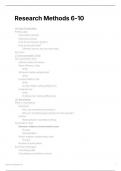Class notes
Lecture notes (6-9) Statistical Methods (semester 2)
- Course
- Institution
Lecture notes (6-9) for Research Methods in 2nd semester. All essential notes from lectures for upcoming exams. Made in Notion with a sleek, readable design (complete with contents, images, tables and summaries).
[Show more]



